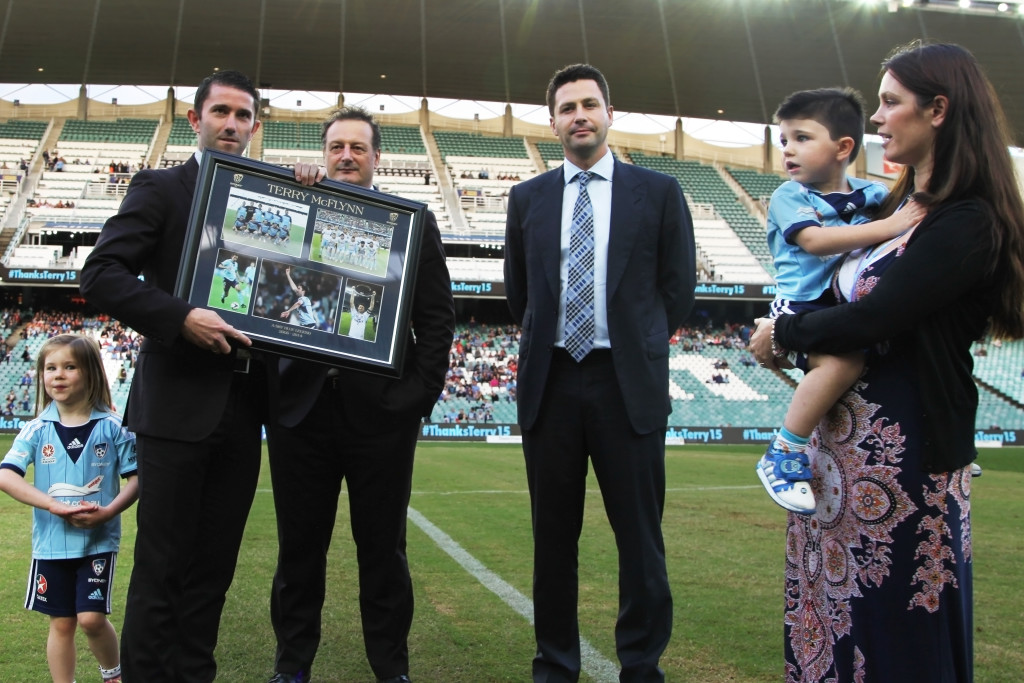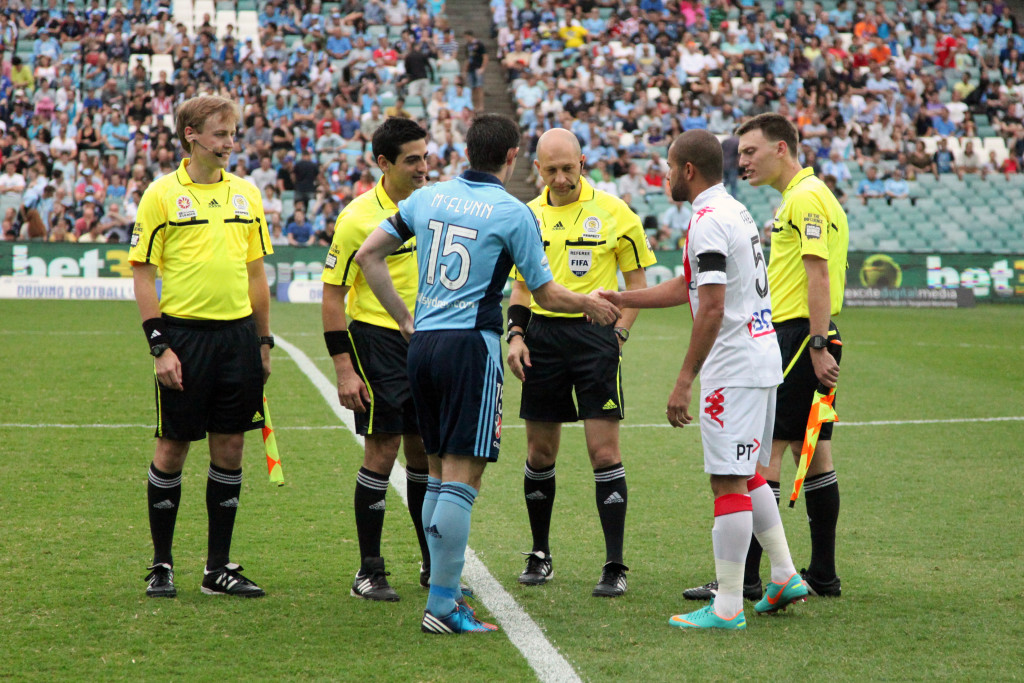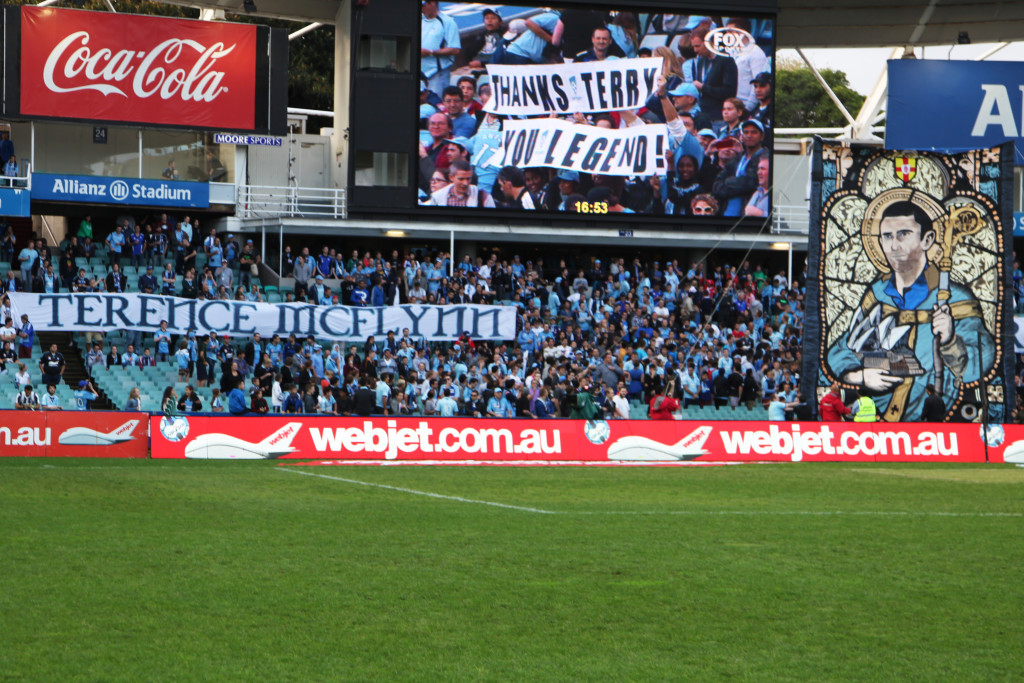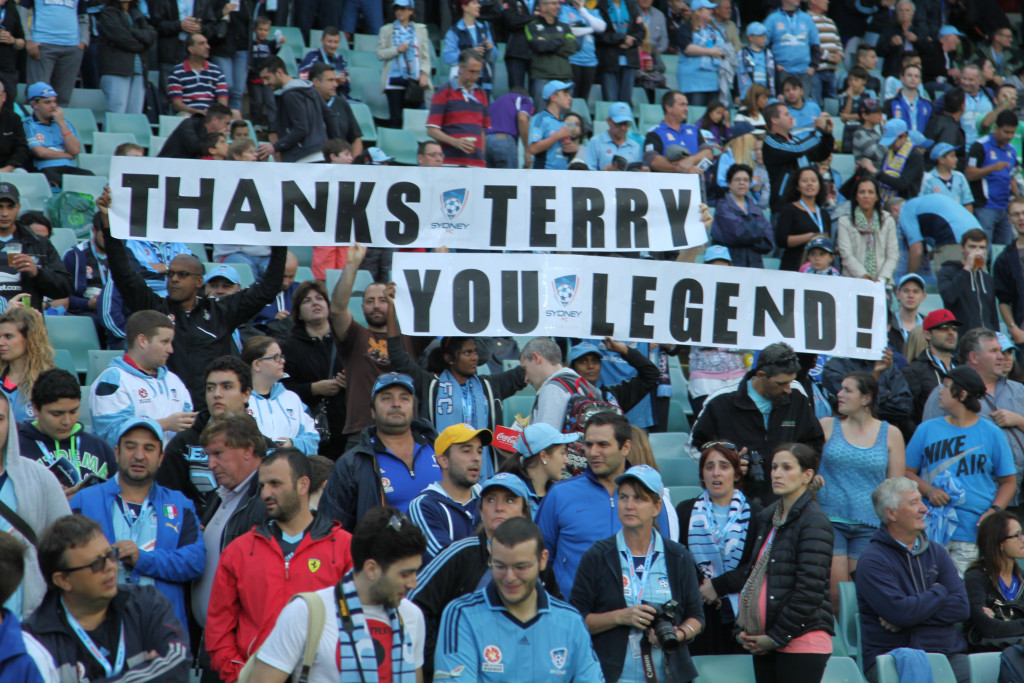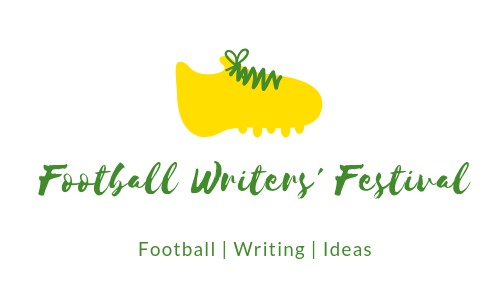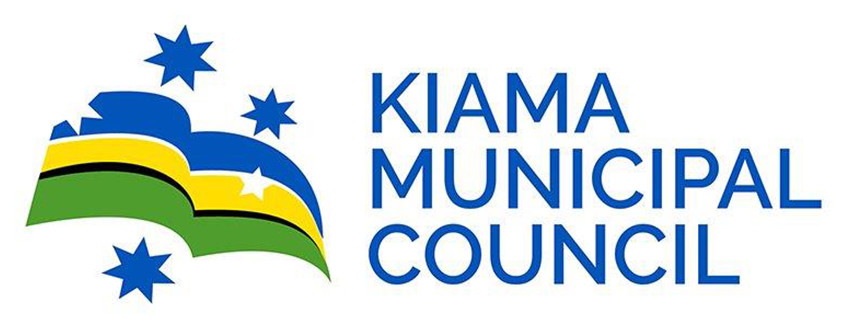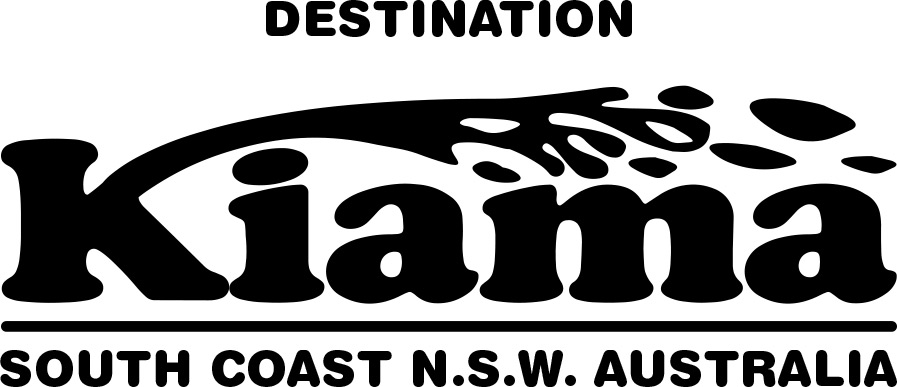For more than twenty years, Terry McFlynn has devoted his life to the cause of football.
There are very few players who can boast a record of nine seasons with a club as McFlynn achieved in his 204 matches for Sydney F.C.
In his position as General Manager of Football Operations at the club, he applies his vast experience gained in the UK and Australia.
In this interview with Roger Sleeman, Terry McFlynn reveals all the great experiences of his wonderful football journey.
ROGER SLEEMAN
Where did it all begin?
TERRY McFLYNN
I grew up in a Northen Irish village where we played hurling and Gaelic football. I only started playing football at the age of eleven with a few schoolmates and we put a team together to play competitively.
We never played football at school so the competition was played at the weekend and we also trained a couple of times a week.
R.S.
When was it apparent you could play at a higher level?
T.M.
I was fortunate to be selected for the county side, Derry, to play in the Milk Cup at u/14 level and there were a lot of scouts present from England, Scotland and Europe. I was invited to a few trials which led to my selection in the u/15 Northern Ireland Schoolboys.
My football career had certainly fast tracked.
R.S.
Every Northern Ireland footballer and supporter looked up to George Best.
How did he affect you?
T.M.
When you’re travelling the world playing football and you say you’re from Northern Ireland, the first person mentioned is George Best.
He played in an era with real stars like Bobby Charlton and Denis Law when Manchester United were the team people wanted to follow and when you played in the streets, everybody wanted to be like George.
We’d recreate some of his great games like the hat-trick he scored at Wembley in the 1968 European Cup Final and the goal he scored in the NASL for the Los Angeles Aztecs when he beat a whole team.
I was fortunate to meet George a few times when I was playing for the national team and he was in the media. All the teams would be together, flying through Europe and listening to George’s stories both on and off the pitch.
R.S.
Which other Northern Ireland players were your heroes?
T.M.
Before my time there was Norman Whiteside but also my contemporaries, Neil Lennon, Keith Rollins and Alan Macdonald who was captain of QPR when I first went there.
In later years Steve Davies, Rangers and Southampton and Keith Gillespie who was part of the famous swap for Andy Cole to go to Manchester United when Gillespie went to Newcastle United.
When I was in the u/21 squad, we would travel with the full team whose manager was the legendary, Sammy McIlroy.
There were also Gerry Taggart, Chris Baird and Steve Lomas.
R.S.
Did you ever meet Pat Jennings, the former Northern Ireland goalkeeper, who ranked as one of the best ever?
T.M.
When I was at QPR, Pat was an ambassador for Tottenham and his son, Pat Junior, came and played with us after leaving Wimbledon before they became Milton Keynes Dons. He played a few games for us before he went back to Northern Ireland to play for Derry City.
He was a great goalkeeper like his father and played u/21’s with me. His first game was against Malta away when we won 3-1.
There was a famous game when he saved three penalties for Derry City.
R.S.
What led to your signing by QPR as an apprentice?
T.M.
It was the time when I was playing with Northern Ireland Schoolboys and we were playing the Victory Shield between the Home Nations and I played against England who fielded Frank Lampard, Joe Cole, Michael Carrick, Leon Osman and Francis Jeffers.
We played against Joe Cole at Windsor Park and we couldn’t get the ball off him.
I also played in the annual Wilkinson Shield against the Republic and John O’Shea played for them in front of all the scouts.
After that game, the Manchester United coaching director, Dave Bushell, invited O’shea and I to the club for a week to work under Paul McGuiness who was a wonderful coach.
The following holidays, I was invited to QPR and played a few games there in the u/16’s.
After I came back home to play Wales, I was approached by QPR who offered me a five year contract at the age of sixteen.
R.S.
What was it like at QPR and how hard was it to make the grade?
T.M.
Every kid wants to be a footballer at professional level so you realise how privileged you are to get a contract.
I never took it for granted and when I walked into the dressing room at Loftus Road and saw first team players Trevor Sinclair, John Spencer, Alan Macdonald, Simon Barker and Dave Bardsley, I was in awe.
However, in that first year we were relegated to the Championship and Stuart Houston and Bruce Rioch came in as managers.
Opportunities are limited because it’s so competitive but I was in the first team squad and mainly played youth football to start with. West Ham won the League with players of the calibre of Jermaine Defoe, Michael Carrick, Joe Cole, Michael Ferrante and Richard Garcia.
It was a great foundation for me as we trained every day and I really learned my trade with the fundamentals of dedication and application.
R.S.
Why didn’t you play more first team football?
T.M.
We went through the ITV digital collapse and the club went into administration but I did play two first team games against Stockport County and Wolves who Steve Corica was playing for.
Ian Holloway was the boss and nineteen of us were released on the same day in 2001.
A lot of players fell into the Conference and funnily enough there was more money there than in the Football League.
It was the Nationwide Football Conference and I went to Woking and was earning more than I was at QPR.
Woking had ambitions to play in the Football League but there were over thirty players competing to play in the first team so the manager said you can go if you want.
I was fortunate to have a contact at Margate who needed a midfielder so I was lucky to sign there.
Until I came to Sydney it was my best time in football as the team had been promoted four times before getting into the Conference with the same group of players?
We achieved results and I was still able to play for Northern Ireland U/21’s.
I eventually signed for Morecambe and we won the Lancashire Cup.
However, in the second year, my wife wanted to go back to Australia and the manager ok’d it. I applied to a few A-League clubs and Sydney replied.
Fortunately, I was successful after trialling.
R.S.
In your career as a defensive midfielder, would you like to have been allowed more freedom to get forward?
T.M.
It’s a team game and I was always prepared to play a role, which reminds me of the famous quote, “There are piano players and piano carriers”.
I was mainly a piano carrier but I saw it as a privilege to play behind some famous players, especially in the 2006 A-League Grand Final at Allianz Stadium when Steve Corica scored after Dwight Yorke made a run behind the Mariner’s defence and laid it off for Corica to place the ball past Vukovic.
That season, I had the best seat in the house watching Corica at number 10, Petrovski and Zdrilic upfront and Carney and Middleby playing wide up the flanks.
I used to interchange with Talay going forward and coach, Littbarski, wouldn’t mind who was in the box, as long as we maintained our shape.
R.S.
Who were the best players you played with at Sydney F.C and the fiercest opponents in your career?
T.M.
Corica in that first year, Dwight Yorke who I learned so much from, Juninho before he damaged his shoulder, Carbone, Del Piero, especially in his first year and Brosque.
Best opponents were Fernando Torres who I played against in Spain on a tour with QPR and was impossible to mark, Joe Cole and Ruud Gullit who was player manager for Chelsea in the reserves and although in his early forties, we couldn’t get near him.
In the A-League, Carlos Hernandes had immaculate control, could find players from any range, beat players, had a powerful shot on both feet and just dictated the pace of the game.
R.S.
How did the opportunity arise to stay at Sydney FC after you announced your retirement from the A-League?
T.M.
I went to Sydney University to do a Master’s degree in Coaching Education as I always wanted a coaching career and also received my coaching badges.
I have a great relationship with Scott Barlow and a position arose for General Manager of Player Welfare which concentrated on reducing stresses and strains off the field which were affecting on field performance.
I acted behind the scenes with players, their families and new players in relation to housing, kid’s schooling or any other issues.
As an ex-player, I always believed happiness in outside life always promotes better performance on the field.
The role reverted to A-League Football Manager where I was responsible for facilities and player welfare and I was finally appointed as G.M. of Football Operations, acting for the A-League, W-League, NYL and NPL.
R.S.
Many people believe the standard of the A-league has been better.
How do you rate it?
T.M.
I believe it’s getting better with sports science advances, improved facilities e.g. our Macquarie University setup which has great pitches, conference rooms and gym.
In contrast, we trained at Football NSW in the early years and shared change rooms.
Also, there are good young players like Luke Ivanovic emerging at our club as well as the Academy with 5-6 new players in the frame to make it to the top.
R.S.
In a number of Sydney FC matches this season, Adam Le Fondre, despite his excellent goal tally, has been isolated up front?
How can this be rectified?
T.M.
The loss of Trent Buhagiar’s pace has been a big loss and we worked hard to replace him. The signing of Reza will hopefully make a big difference as his pedigree was superb and we have him to the end of the season to assist Le Fondre.
Also, we shouldn’t forget Alex Brosque who can still make a big impact in the front third.
Nevertheless, Steve Corica sets up the team to get forward quickly and put bodies in the box.
R.S.
What about Josh Brilliante who has one of the most powerful shots in the League and rarely comes forward?
TM
Brilliante had shots against Brisbane two weeks ago and didn’t hit the target but we know what he’s capable of.
R.S.
What about Mitch Duke?
T.M.
We spoke to him and he’s a good player but different to what we wanted. Also there was a problem with the salary cap.
R.S.
How do you rate Steve Corica’s coaching performance this year?
TM
It is early days for Corica as the transition is with any new team boss when you’re inheriting players but Steve is totally professional as he proved when he won the NYL and has great assistant coaches in Robbie Stanton and Ufuk Talay.
R.S.
Are there enough good coaches in Australia?
T.M.
Money is a problem but foundation years for players who intend to coach are critical because that was where I got my football education.
We should be encouraging more former players to be involved in coaching.
In saying that, there has to be a clear pathway for players to graduate to coaching ranks when they retire and an end to the continual chopping and changing in the system.

